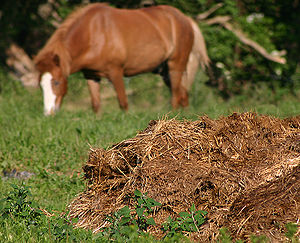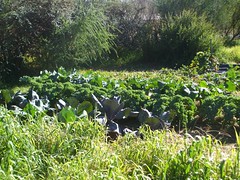Use of this fertilizer method improves the soil and prevents it from compacting and crusting. It increases the water’s holding ability so earthworms and other microorganisms can aerate the soil and it slows down erosion and in later stages of decay so that organic matter is able to release nitrogen and other nutrients which help the crops grow.
Such a technique is old but is now making a come-back because the conventional method of using synthetic materials like fertilizer and pesticides have ruined the soil and depleted it of organic matter so it cannot be used for replanting (or if it is, the food that comes from it is extremely lacking in nutrients).
 Image via WikipediaSo where do we get this organic matter? Believe it or not, the best form of organic matter comes from animal manure. The fresher the better because you can apply this directly to the soil, but this should only be done in the fall and plowed down to give it adequate time for sufficient breakdown and ammonia to release before the planting season begins — otherwise it can burn the roots and leaves of the new plants.
Image via WikipediaSo where do we get this organic matter? Believe it or not, the best form of organic matter comes from animal manure. The fresher the better because you can apply this directly to the soil, but this should only be done in the fall and plowed down to give it adequate time for sufficient breakdown and ammonia to release before the planting season begins — otherwise it can burn the roots and leaves of the new plants.If you don’t have access to fresh animal manure, you can use the dried version that is being sold in nurseries and garden stores.
For those who don’t want to use manure, you can use compost instead. This can be made from lawn clippings, leaves, food waste and other plant materials. It is cheap but its nutrient content is lower. (See previous posts on composting for more on this).
 There is also another kind of manure better known as green manure. This comes not from animal waste, but rather by growing a rich cover crop in your garden and then plowing it under so you are adding organic matter to the soil. The best way to maximize this is for you not to use the garden for one season.
There is also another kind of manure better known as green manure. This comes not from animal waste, but rather by growing a rich cover crop in your garden and then plowing it under so you are adding organic matter to the soil. The best way to maximize this is for you not to use the garden for one season.You can also seed the green manure in the fall and then turn it under with a plow or a large tiller in the early spring. That way, you can use your garden normally in the summer season, while at the same time building up the soil during the later half of the year.
Annual ryegrass is a good example for green manuring and covering. This should be seeded 1 to 2 feet per 1,000 square feet. If this is not available, you can use seed rye or wheat and place it 3 to 4 feet per 1,000 square feet. This also helps prevent weeds from growing; in order for this to be most effective, wait at least 2 weeks before you start planting.
Sewage sludge is also a good source of organic matter. There are two types namely digested sludge and dried activated sludge.
The first is relatively low quality. It contains from 1 to 3 percent of nitrogen and should only be applied during the fall. But you should be careful when you use it because it sometimes contain metal ions that are not good to use on vegetable gardens.
The second which is the dried activated sludge has been separated from coarse solids, inoculated with microorganisms and aerated. This is better than the other one because it is filtered, dried in kilns and screened. It contains 5 to 6 percent of nitrogen and 5 to 7 pounds can cover an area of 100 square feet.
Take note that these two types are different from raw sewage, which should NEVER be used to garden in any soil.
Sustainable organic vegetable gardening can only happen with the prudent and educated use of natural organic matter. Choose from the methods above to find what will work best in your situation, and get gardening!
And as always, we’d love to hear your tips and comments on what organic fertilizer methods have worked best for you in your garden, so please feel free to post below!
Related articles on Organic Fertilizers & Sustainable Gardening:
- Preparing to Prepare: Amending Your Garden Soil, by Windwillow (survivalblog.com)
- Recycling animal and human dung is the key to sustainable farming (energybulletin.net)
- Identifying Your Soil Type and Preparing Your Site (gliving.com)

Cool site, I hadn’t come across newholisticliving.wordpress.com previously in my searches!
ReplyDeleteKeep up the fantastic work!